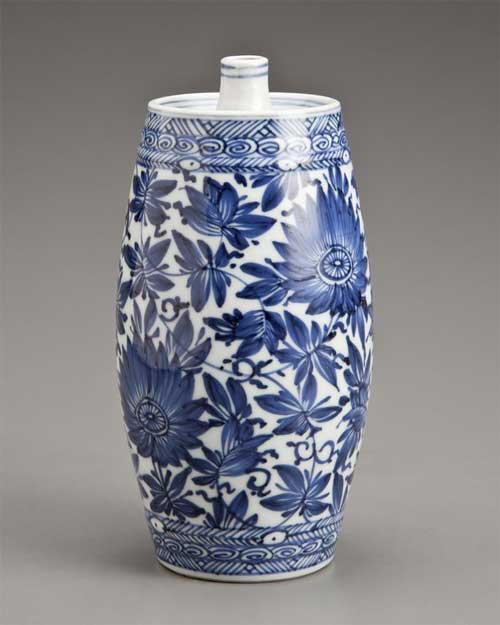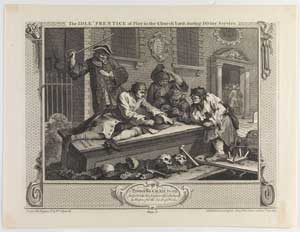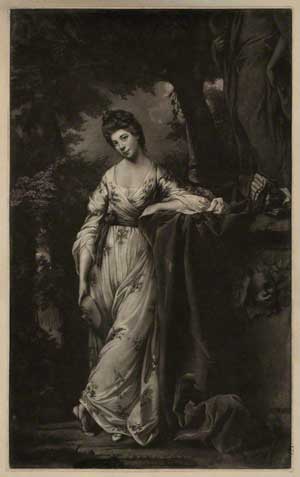Images

John Hamilton Mortimer, Caliban (engraving, mid century).
Mortimer (1740–1779) was known in the 1770s for his gothic imagery of monsters, witches, and, most famously, the banditti scenes imitative of the seventeenth-century artist Salvator Rosa. Folger: ART Box M888 no. 12.
From The Tempest
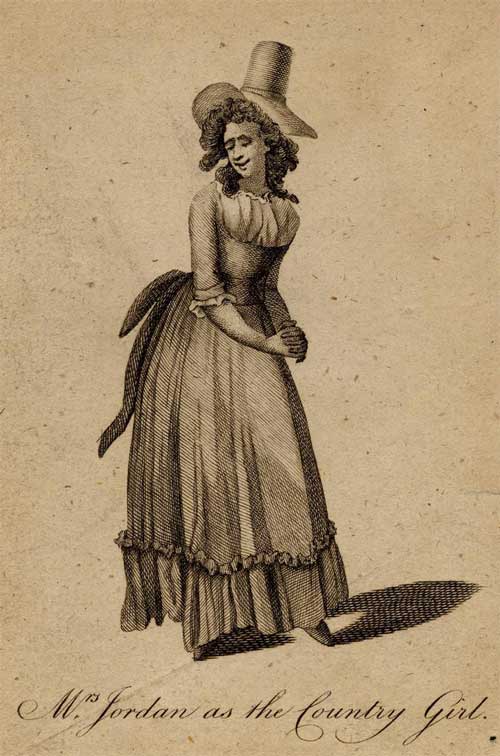
John Ogborne, Dorothy Jordan in the character of the “Country Girl.”
From The Country Wife
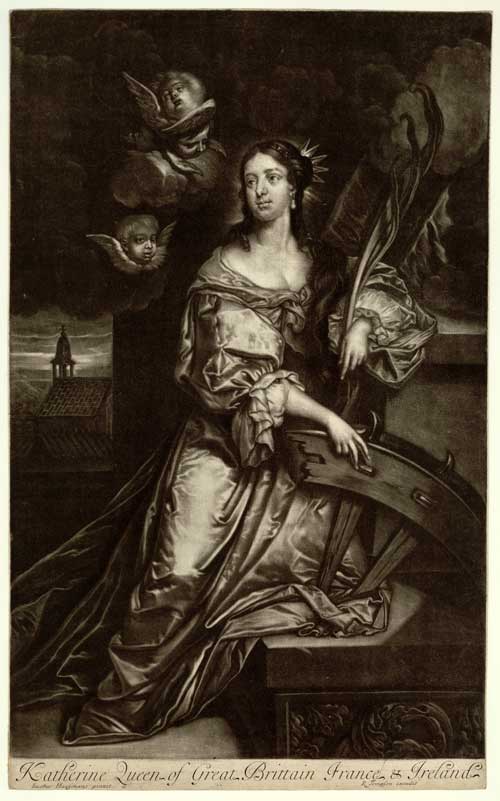
Catherine of Braganza, published by Richard Tompson, after Jacob Huysmans.
Catherine, the long-suffering queen of Charles II, is shown here as St. Catherine, along with a portion of the wheel upon which she was broken and died. National Portrait Gallery, London.
From All For Love

Mrs. Bracegirdle. S. Harding, delin., James Stow, sculp. London: James Stow, 1770.
Anne Bracegirdle was adopted by Thomas Betterton and his wife Mary. She grew up in this theatrical family and went on to play Semernia in The Widdow Ranter, Millamant in The Way of the World, and a variety of breeches roles. Folger: ART File B796 no. 1.
From The Way of the World
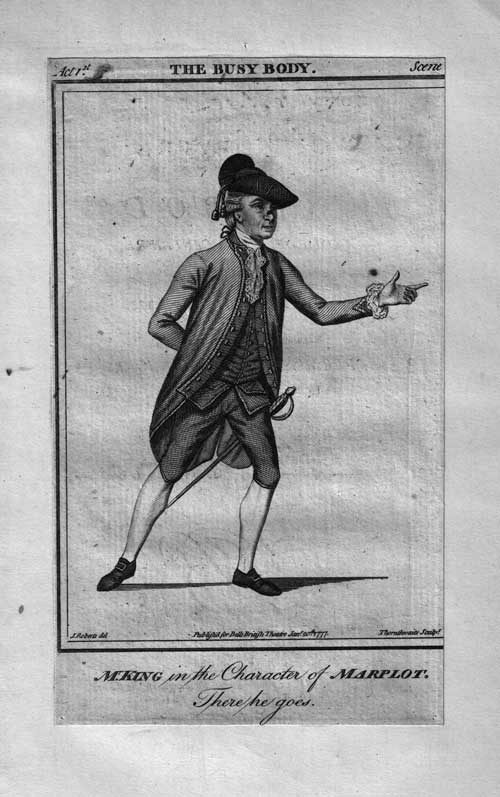
Thomas King as Marplot
Thomas King as Marplot (engraving, 1777). This image of King as Marplot is an example of the popularity of small engraved images of actors in character. Marplot sports a bandage or plaster on his nose, indicating his haplessness and past beatings. The prints also appeared in and help to advertise the collection Bell’s British Theatre.
From The Busie Body

Mr. Munden as Sir Francis Gripe in The Busy Body. De Wilde, pinxet.
Bell’s British Theatre, London: George Cawthorn, 1791. Folger: ART File M965.6 no.3.
The image shows Munden as Gripe waving the £100 that Sir George Airy has given him for the short audience with Miranda, and the inscription below includes his line as well as the stage direction...
From The Busie Body
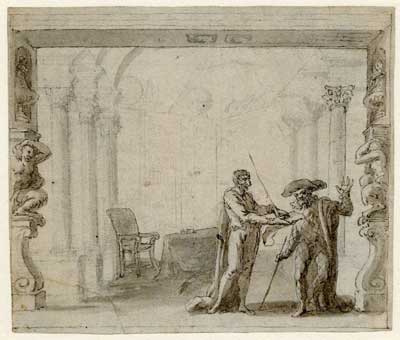
John Thurmond’s pantomime “Harlequin Dr. Faustus.”
Scene One of ‘The Necromancer or Harlequin Dr Faustus’ which opened at Lincoln's Inn Fields 20 December 1723.
This print, taken from The Necromancer, or Harlequin Dr. Faustus, shows a stage with an arch and crouching satyrs supporting urns. On stage, Mephistopheles (played by Richard Leveridge) is receiving the contract from Harlequin Faustus (played by John Rich). Upstage, we can see Faustus’s study, designated by his chair and table. The British Museum labels the print as from Thurmond’s pantomime, though the image allegedly shows Rich. Anonymous, 1724. Trustees of the British Museum.
From The Necromancer, or Harlequin Doctor Faustus and Harlequin Doctor

Mr. Bannister in the character of Miss Polly Peachum. 1781. James Sayers, printmaker. Courtesy of the Lewis Walpole Library, Farmington, CT.
This portrait of Bannister cross-dressed is part of a culture of gender-bending performance around The Beggar's Opera, which included several female Macheaths, among them, Miss Catley and Charlotte Charke, and in the nineteenth century, Eliza Vestris. Gay’s sequel Polly, which takes place on a West Indies plantation, wrote cross-dressing into the title role.
From The Beggar's Opera

Pepusch score.
John Christopher Pepusch scored the overture and the incidental music for The Beggar’s Opera. Like Handel, Pepusch was German-born and succeeded in Hanoverian Britain. Though he was best known for The Beggar’s Opera, he also wrote other church and secular music. The International Music Score Library project hosts copies of many of Pepusch’s works at IMSLP Compositions. Multiple versions of the complete Beggar’s Opera score are available as open-source materials at IMSLP Sheet Music.
From The Beggar's Opera

Mr. Quick in the Character of Tony Lumpkin
Victoria and Albert Museum, London.
From She Stoops to Conquer
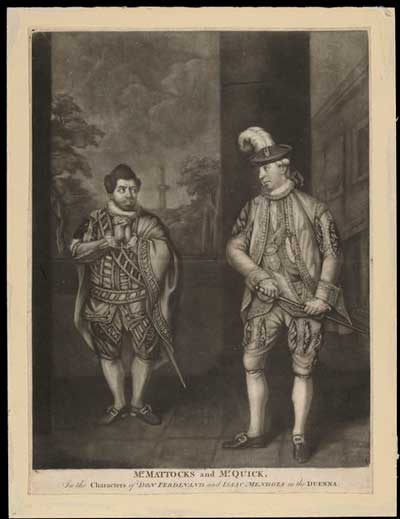
Carrington Bowles, Mr. Mattocks and Mr. Quick
Carrington Bowles, Mr. Mattocks and Mr. Quick in the Characters of Don Ferdinand and Isaac Mendoza in the Duenna. Victoria and Albert Museum, London.
From The Belle's Stratagem

James Fittler (after Richard Cosway)
James Fittler (after Richard Cosway), Mrs. Cowley, stipple etching and engraving, 1785. Trustees of the British Museum.
From The Belle's Stratagem

George Cruikshank, Wowski Lottery Ticke. Trustees of the British Museum.
From Inkle and Yarico

William Hogarth, Industry and Idleness, London, 1747. Courtesy the Lewis Walpole Library, Yale University.
Hogarth’s series of 12 plates about the rewards of diligence for the industrious apprentice (Francis Goodchild) and the consequences of idleness for his companion, Tom Idle. Like many of Hogarth’s “progresses,” this series charts a trajectory of narrative consequences from the main characters’ choices. The set was originally engraved to be sold for a shilling apiece, putting the set or individual prints within the financial grasp of a wide market of consumers.
From The London Merchant

Foote, the Devil, and Polly Pattens. Published in The Macaroni & Theatrical Magazine 18 Feb. 1773.
The Victoria and Albert Museum, London. Foote took up the torch as patentee at Fielding’s old Little Theatre, Haymarket, but tore down the old theatre and rebuilt a new one on the same site, with a capacity of a thousand, after his first season. To recover his costs he asked to have his license extended past the summer season; when it was not, he went around the licensing laws (something he had done before with his morning “concerts” and his Dish of Tea and Dish of Chocolate performances by presenting a satirical puppet show in February 1773. Alternately called, The Primitive Puppet Show and The Handsome Housemaid, or Piety in Pattens, the play parodied sentimental comedy, acting styles in general, and David Garrick, with Foote voicing most of the puppets. When asked whether the puppets were life-size, Foote allegedly replied by saying that there were not, as they were not much bigger than David Garrick. Garrick nonetheless attended the show and praised Foote’s genius.
From The Minor

Anon., The Rev. Mr. Whitefield Preaching at Leeds, 1749.
Courtesy of the Lewis Walpole Library, Yale University. This anonymous image shows Whitefield preaching before a crowd in Leeds. His arms are spread wide in an approximation of a theatrical gesture, and he holds his handkerchief, a reference to his frequent practice of crying during his own sermons.
From The Minor

“Squintum’s Farewell to Sinners,” London: M. Darly, 1760.
Courtesy of the Lewis Walpole Library, Yale University. This print, which appeared after Foote’s satire, shows how firmly the name “Squintum” stuck to Whitefield. Whitefield addresses the primarily female crowd with a sermon declaring “my great, my strong love for you” while various women respond. One exclaims “Oh! Dear Squintum! Let me come under your direction,” while another wonders “I don’t know whether Squintum or my soldier has got me with child.” Another says she has pawned her last for her two favorites, “gin and Squintum,” while other women are more suspicious of his message.
From The Minor
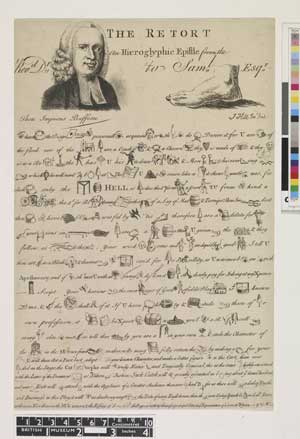
The Retort, an Hieroglyphic Epistle from the Rev. Dr. [Whitefield] to Saml [foot, i.e. Foote] Esqr. J. Hill Invt. Scul. Trustees of the British Museum.
This satirical rebus comments on the print war between the supporters of Whitefield and those of Foote. While Whitefield only made one mention of it in his letters, it seems clear that his supporters, perhaps at his urging, were quick to defend him in print. A long series of articles and letters in Lloyd’s Evening Post in 1760 brought John Wesley into the fray; he responded November 17–19 with a letter of his own. This print was advertised in the Public Advertiser December 6, 1760.
From The Minor

“Miss Macaroni and her Gallant at a Print Shop.” J. Smith fecit, printed for John Bowles, at No. 13 in Cornhill, published April 2, 1773. Courtesy of the Lewis Walpole Library, Farmington, CT.
The image shows a fashionable young woman (a female “macaroni”) admiring prints that feature scenes from popular plays along with popular preachers, including John Wesley and George Whitefield.
From The Minor
